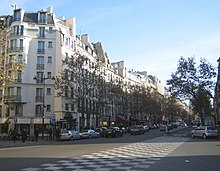Arab Congress of 1913 | |
|---|---|
 Société de Géographie | |
| Type | |
| Type | |
| History | |
| Established | June 18, 1913 |
| Disbanded | June 23, 1913 |
| Meeting place | |
 | |
| Paris, France, Boulevard Saint-Germain at the corner of Rue de Buci. Buildings shown between the corner of the rue de Buci and rue de Seine are the original North side of the former rue des Boucheries. | |
The Arab Congress of 1913 (also known as the "Arab National Congress,[1]" the "First Palestinian Conference," the "First Arab Congress,[2]" and the "Arab-Syrian Congress[3]") met in a hall of the French Geographical Society (Société de Géographie) at 184 Boulevard Saint-Germain, Paris from June 18–23 in Paris to discuss more autonomy for the Arab people living under the Ottoman Empire. Furthermore The Arab National Congress, which was established by 25 official Arab Nationalists delegates, was convened to discuss desired reforms and to express their discontent with some Ottoman policies. It took place at a time of uncertainty and change in the Ottoman Empire: in the years leading up to World War I, the Empire had undergone a revolution (1908) and a coup (1913) by the Young Turks, and had been defeated in two wars against Italy and the Balkan states. The Arabs were agitating for more rights under the fading empire and early glimmers of Arab nationalism were emerging. A number of dissenting and reform-oriented groups formed in the region of Syria, Palestine, Constantinople, and Egypt. Under Zionist influence, Jewish immigration to Palestine was increasing, and England and France were expressing interest in the region, competing for spheres of influence.
It was under these conditions that a group of students living in Paris called for a Congress to be held to discuss proposed Arab reforms. According to Najib Azouri, the real organizers of the congress were Chekri Ganem and the Moutran brothers, the rest were moutons de Panurge.[4] While the Congress was not ultimately successful in its proposed aims, it was a reflection of events taking place and dynamics that shaped the early 20th century for three continents before World War I began. Many scholars place the origins of Arab nationalism during these crucial years that witnessed a dwindling of empires and a build-up of tension surrounding Zionist immigration to Palestine and Arab reaction to it. The whole Congress declared itself ready to struggle to bring the Arab Nation into being by means of revolution. Al-Hoda Editor and Lebanese League of Progress President, Naoum Mokarzel started cautiously by saying that: “The Revolution must be literary and reformist”, he continued more aggressively “only the last resort should it be bloody, because the political systems of free nations have been constructed by martyrs and not with printers ink.”[5]
- ^ Tibi, Bassam (1981). Arab Nationalism: A Critical Enquiry. St. Martin's Press. p. 84. ISBN 0-312-04716-9.
- ^ Thomas, David (1976). Donald P. Little (ed.). Essays on Islamic Civilization. E.J. Brill. p. 318. ISBN 90-04-04464-7.
- ^ Dockser Marcus, Amy (2007). Jerusalem 1913. Viking. ISBN 9780670038367.
- ^ Jung, Eugène (1924). La révolte Arabe: Les coulisses de l'histoire. p. 67.
- ^ Tibi, B. (April 11, 1997). Arab Nationalism: Between Islam and the Nation-State. Palgrave Macmillan UK. ISBN 0312162863.